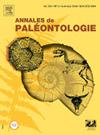Les empreintes de dinosaures du Jurassique inférieur de Peyre (Aveyron, France) : fouille récente et nouvelles données ichnologiques révélées par imagerie 3D
IF 0.7
4区 地球科学
Q4 PALEONTOLOGY
引用次数: 0
Abstract
At the end of the 20th century, dinosaur footprints were discovered at Peyre, in Aveyron (Causses Basin, southern France). At that time, the tracksite was limited to a single fossiliferous surface bearing a dozen of Lower Jurassic footprints. Recent excavations (2022–2024), led along a 23 m thick stratigraphic section revealed six additional track-bearing surfaces. Dinosaur tracksites showing such a high density of track-bearing surfaces along such a short section are uncommon in the fossil record and extremely rare in the Causses Basin. Today, the tracksite displays 126 footprints some of which reach 49 cm in length. Tracks are preserved in situ as concave epireliefs on the surface of dolomitic beds. Some footprints are well-preserved, showing details of digit, pad and claw marks. The excavation and 3D modelling by photogrammetry revealed several morphologies of tridactyl footprints. Biometric analyses combined with photogrammetric imaging indicated the co-occurrence of three ichnotaxa: Eubrontes giganteus, Grallator variabilis and Kayentapus isp. The high density of footprints unidirectionally oriented suggests repeated passages of theropods whose migrations were restricted by local physical barriers (coastlines, topography). Tracks are preserved in dolomite with cryptalgal laminites, mud cracks and ripple marks. The depositional environment is interpreted as a tidal flat periodically flooded then emerged.
佩尔(法国艾维隆)侏罗纪晚期恐龙足迹:通过3D成像揭示了最近的挖掘和新的葡萄酒学数据。
20世纪末,在法国南部阿韦隆(Aveyron)的佩尔(Peyre)发现了恐龙脚印。当时,这个足迹地点仅限于一个化石表面,上面有十几个下侏罗纪的脚印。最近的挖掘(2022-2024),沿着23米厚的地层剖面,发现了六个额外的轨道表面。在化石记录中,在这么短的一段时间内,显示出如此高密度的脚印表面的恐龙足迹遗址是罕见的,在科斯盆地更是极为罕见。今天,这个足迹站点展示了126个足迹,其中一些长达49厘米。痕迹在白云岩层表面以凹状上浮雕的形式保存下来。有些脚印保存完好,显示了手指、脚掌和爪印的细节。通过摄影测量的挖掘和三维建模揭示了三趾类足迹的几种形态。生物特征分析结合摄影测量成像结果表明,该地区共存在3个鱼类群:Eubrontes giganteus、Grallator variabilis和Kayentapus isp。高密度的单向足迹表明兽脚亚目恐龙的迁徙受到当地物理障碍(海岸线、地形)的限制。痕迹被保存在白云岩中,带有隐晶层,泥裂缝和波纹痕迹。沉积环境被解释为潮汐滩周期性地被淹没然后出现。
本文章由计算机程序翻译,如有差异,请以英文原文为准。
求助全文
约1分钟内获得全文
求助全文
来源期刊

Annales de Paleontologie
地学-古生物学
CiteScore
1.70
自引率
10.00%
发文量
8
审稿时长
>12 weeks
期刊介绍:
Créées par Marcellin Boule en 1905, les Annales de Paléontologie publient 4 numéros par an traitant des fossiles animaux et végétaux, dans tous les domaines de la paléontologie incluant :
-La Paléoanatomie-
La Paléohistologie-
La Morphologie fonctionnelle-
La Systématique-
L''Évolution-
La Paléoécologie
... et toute les contributions susceptibles d''améliorer la compréhension des organismes et des environnements éteints.
 求助内容:
求助内容: 应助结果提醒方式:
应助结果提醒方式:


